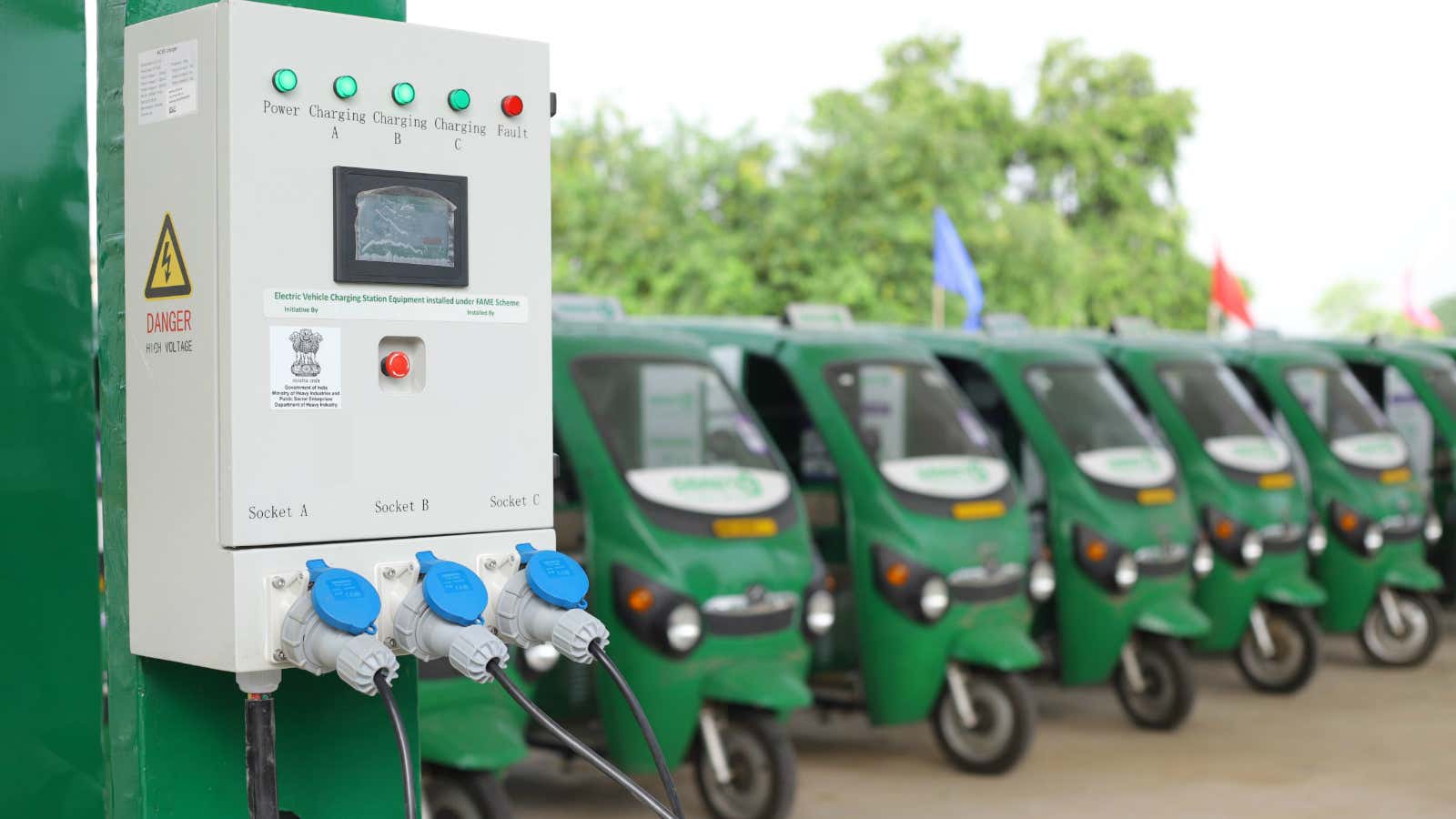A former journalist may finally have the solution for India’s twin-problems of mobility and pollution.
Gurugram-based SmartE, the only company in the country to own and operate electric three-wheelers, is fixing the issue of first- and last-mile connectivity in and around the national capital, even as it ramps up the infrastructure for its eco-friendly commute network.
For now, SmartE’s eponymous three-wheelers operate from near a handful of Delhi Metro stations in the northern Indian cities of Gurugram, Faridabad, and Delhi. Its CEO Goldie Srivastava now plans to expand its presence to up to 120 stations over the next 12 and 18 months.
Srivastava, who quit journalism in 2005 and dabbled in corporate jobs for around a decade, launched SmartE in 2014. In October the following year, the first batch of the company’s 30 electric three-wheelers was rolled out.
Initially bootstrapped, the company raised $5 million in series A funding a year-and-a-half ago from the Singapore-based EcoTransit Investments International.
This August, it expanded its operations to New Delhi in partnership with the Delhi Metro Rail Corporation (DMRC). “Presently about 800-1,000 vehicles are deployed (outside more than 10 metro stations),” Srivastava said in an interview.
For now, SmartE is focussing on volumes, which makes its rides affordable at Rs10 per two kilometres. As of September 2018, it was transporting an average of around 80,000 commuters a day with about 1,000 driver partners.
Edited excerpts:
How did the idea of SmartE take shape?
The entire first- and last-mile connectivity in India today is being delivered by an industry that has been unorganised for the last 50-60 years. There’s very little oversight, very little professionalism. If you have taken the Delhi metro, you’d realise that for world-class, air-conditioned transportation, you pay maybe Rs20 for 8-10 kilometres. The moment you come outside the station, you’d probably have to pay Rs50 for the last two kilometres.
So I thought: “Can I organise this space to whatever extent I can.” This was the time when Ola and Uber had taken shape. It was also the time during which Delhi was labelled as the world’s most polluted city. So I ruled aggregating three-wheelers out. I also realised the global automotive industry is going electric.
That’s how our journey began.
Was it difficult to get funding, given the lack of awareness about electric mobility?
I had to bootstrap the company for the first two-and-a-half years because of little investor interest. I pooled my life’s savings into this. We raised our series A funding a year-and-a-half ago.
What were the other challenges you faced while starting out?
We spent seven months running from one bank to another to get at least 50 vehicles financed. We were planning to get operational by March 2015 but it took us another six months. Then the batteries available then would just go dead in three-six months. However, government policy-wise, there was no issue.
Recently you announced a partnership with DMRC. What are the details of the agreement?
From the beginning itself, SmartE has worked closely with Delhi metro, although there was no formal partnership. We used to park about 30 vehicles outside a few metro stations and tried to study customer responses. The feedback was good.
We soon realised that the commuting (problem) was more acute in Gurugram. So, we ran pilots for a year there from March 2016-17. By this time, the DMRC realised that last mile connectivity was a huge challenge for them. They rolled out a tender, which we won. And now we plan to expand our presence to the next 100-120 stations in the coming 12-18 months.
Do you see cab aggregators like Uber and Ola as competition?
Potentially, yes. But not in the current form. Ola tried to apply its method of aggregation to electric vehicles (EVs), too. Traditional mobility you can aggregate, but electric mobility doesn’t work that way. If you have to aggregate, you have to get those customers first and then aggregate. And to do that, the entire infrastructure has to be robust. Charging infrastructure is a problem now. So either you need to build your own infrastructure or wait till the issues are sorted. The opportunities are immense and I don’t think they (Ola and Uber) will be sitting idle. The last-mile, three-wheeler market today is worth $40 billion in India, by 2020 it will be a $70 billion market. So even they’ll definitely tap into it.
Does SmartE have the required infrastructure?
Electric mobility requires a lot of foundational work. We have India’s largest EV charging infrastructure…the capacity to charge 800 vehicles concurrently. Our vehicles are not parked in the side lanes or colonies. We have five depots—three in Gurugram, one in Delhi and one in Faridabad, in 70,000 square feet of space.
How has the supply chain changed over the years?
Significantly. From 2014 to 2016-end, there were about 150 EV makers in this country. But the products were sub-standard. There were only one or two players who would offer batteries, but they were horrible. I remember in the second month, our entire operations shut down because the batteries deployed went dead. Today we work with some of the best lithium-ion battery makers in the country like Amara Raja Batteries, SUN Mobility, and Exicom.
But the focus of electric mobility still seems to be on private cars…
In India, the narrative on mobility gets restricted to cars. So the hoopla is all about electric cars. The majority of the vehicle stock in the country is two- and three-wheelers and buses. These segments move exponentially larger numbers of people than cars do. And it’s in the public transport system that electric mobility revolution will take place in India. Cars will happen much later on.
How profitable is this business?
The recipe for making this model economically sustainable is in asset utilisation. Every vehicle of ours (carries) 100-120 people a day. We can afford to move people at Rs10 (per two kilometres) because we focus on volumes.
